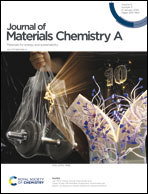Designing a Schottky coupled p–n junction to enhance the kinetic behavior of the oxygen evolution reaction†
Abstract
Achieving an efficient electron transfer process in the oxygen evolution reaction (OER) by modulating electronic states near the Fermi level is essential for developing high-performance electrocatalysts. Herein, we designed a Schottky coupled p–n double heterojunction catalyst (Fe3C-NG@NiFe) assembled from NiFe layered double hydroxides (LDHs, n-type) on N-doped graphite carbon (NG, p-type) coated metal Fe3C. The Schottky junction between Fe3C and NG regulates the electron structure of Fe3C-NG and realizes surface charge redistribution. The local positive charge induced by the p–n junction allows more OH− adsorption by the NiFe LDH side, reversing the OER rate-determining step. Impressively, the Schottky coupled p–n junction introduces additional active sites and two fast electron transfer paths for the OER dynamic reaction. As an advanced OER double heterojunction catalyst, Fe3C-NG@NiFe delivered a low overpotential of 231 mV at 10 mA cm−2 and a small Tafel slope of 41.5 mV dec−1 in alkaline medium. Our work helps us to understand the synergistic catalytic mechanism and enhanced OER kinetic behavior of the Schottky coupled p–n junction, providing a rational strategy for the design of high-performance electrocatalysts for water oxidation conversion.



 Please wait while we load your content...
Please wait while we load your content...